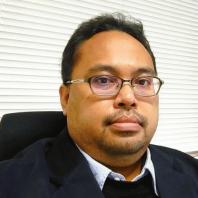![]()
![]()
Research Support Office Research Advancement Division. Tokyo University of Agriculture and Technology
| TEL | +81-42-367-5944 |
|---|---|
| FAX | +81-42-367-5946 |
This program is supported by MEXT’s scientific technology human resource development fee grant, "Program to Disseminate Tenure Tracking System".
Home > Introduction of our tenure-track faculties > Satria Zulkarnaen BISRI

Satria Zulkarnaen BISRI

| Affiliation | Institute of Engineering |
|---|---|
| Division | Division of Advanced Electrical and Electronics Engineering |
| Research field | Quantum nanomaterials and electronic devices |
| Keyword(S) | Colloidal quantum dots, colloidal nanocrystals, self-assembly, hybrid nanomaterials, carrier doping, charge transport, field-effect transistors, electrolyte gating, energy harvesting and storage |
| Url | https://www.sustainable-quantum-nanomaterials-devices.com/ |
| Research experience | •Apr.2006-Jun.2006: MESA+ Institute of Nanotechnology, University of Twente, The Netherlands, Visiting Researcher |
|---|---|
| Educational background | •March 2006: Department of Physics, Institut Teknologi Bandung, Bachelor of Science (B.Sc.) |
| Awards | ・2022: [Supervised Student] 12th International Symposium on Organic Molecular Electronics. |
| Selected papers and publications | ・Retno Miranti, Ricky Dwi Septianto, Tomoka Kikitsu, Daisuke Hashizume, Nobuhiro Matsushita, Yoshihiro Iwasa, Satria Zulkarnaen Bisri. “π-SnS Colloidal Nanocrystals with Size-Dependent Band Gaps”. The Journal of Physical Chemistry C, 126, 5323-5332 (2022). |
My research vision is to develop and exploit designer`s materials primarily based on assemblies or composites of quasi-atom 0D materials (colloidal quantum dots / QDs) as new solid-state materials for energy generation, energy harvesting, energy storage, and very low energy consumption optical-optoelectronic devices. Colloidal QDs are nanometer-sized, zero-dimensional semiconductor crystals that show quasi-atom electronic structure, i.e., discrete energy levels due to the quantum confinement of the charge carriers. The low-dimensional nature sets these material classes as excellent candidates for energy conversion devices. They are compatible with the solution process and the future of additive manufacturing, together with organic semiconductors and carbon nanotubes. The colloidal QD research field lies precisely at the crossing points of physics, chemistry, materials science, and electrical engineering. Research on many fundamental aspects of colloidal semiconductor QDs (i.e., their collective effect on their electrical, optical, and relevant thermal transport studies) worldwide is still in its infancy. The research activities in our group span from the synthesis of the QD materials (with environmental sustainability in mind), the fundamental studies of charge carrier transport, optical properties, thermal transport properties, and the development of practical device applications. Imagine that we can control the electronic structure of each QDs through some modifications and simultaneously arrange the assembly of these QDs into a superstructure. The constructed materials will become designer`s materials, which their properties can be tuned based on the applications that will be developed to answer SDG and the zero-carbon society realization challenges.
The tenure-track program at Tokyo University of Agriculture and Technology provides us opportunity as a young principal investigator to establish an independent research group that is supported by the existing collaborative research environment, generous startup grant, adequate lab space, cross-discipline mentorship, and a mature patronage. Regular exchange meetings among the tenure-track members also allow us to understand and appreciate the progresses in the other research fields, as well as to stimulate possible future collaborations. Personally, this program is vital for me to successfully transition from a full-fledged professional researcher to become a mature academics.
Promoting excellent research and building human resource with good character are intertwined. Together with my students and collaborators, I would like to enjoy the adventures of discovering new science and of building new things, to become more humane and empathetic.